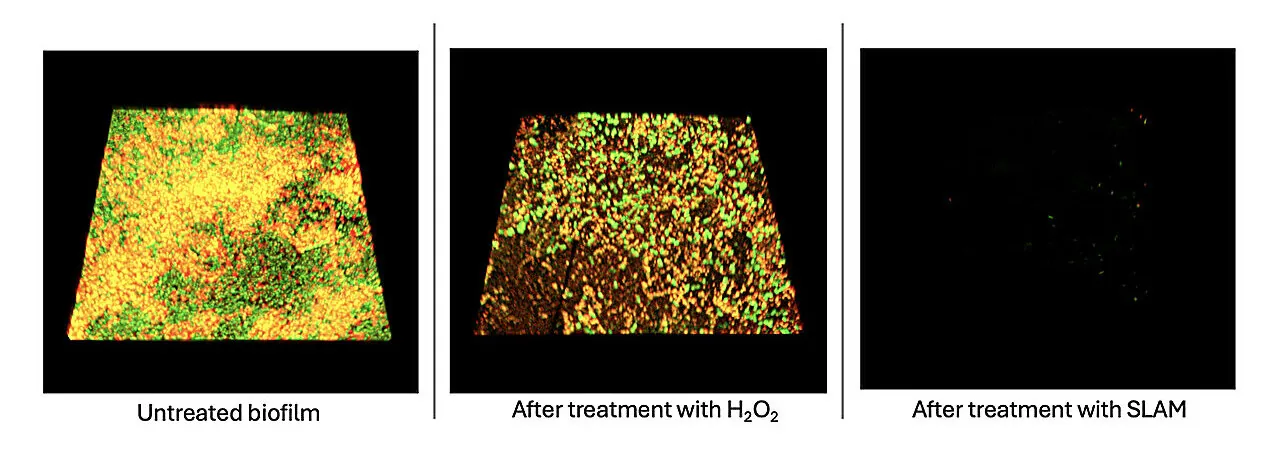
Revolutionary Two-Step Method Breaks Down Bacterial Biofilms, Keeping Your Space Germ-Free for Months!
2025-05-22
Author: Li
Are you tired of the pesky black, gray, or pink stains brought on by bacterial biofilms in your bathroom or kitchen? No matter how much you scrub or what powerful cleaning agents you use, these stubborn clusters seem to bounce back. Well, get ready for some exciting news! A groundbreaking study published in the Chemical Engineering Journal introduces a game-changing two-step method that not only dismantles these unsightly biofilms but also prevents their regrowth for months.
Why Biofilms Are a Bigger Threat Than You Think
Biofilms are everywhere—from our homes to industrial settings. These slimy formations aren’t just gross; they play a crucial role in cross-contaminating patients in hospitals and can even cling to medical instruments like dental and bone implants. Hyunjoon Kong, a leader in this field and professor of chemical and biomolecular engineering, emphasizes that these biofilms are complex communities of bacteria, protected by a tough exterior that allows them to resist even the toughest cleaning agents.
The Challenge of Destroying Biofilms
Many people mistakenly believe that bacterial infections stem from individual free-floating cells. In reality, bacteria operate as a collective, forming intricate structures that shield them from harm. Conventional antimicrobials, including bleach and antibiotics, often fail to penetrate these defenses, leading to stubborn biofilm persistence even after aggressive treatments.
A Breakthrough Approach to Eradication
Kong and his team, led by graduate students Yu-Heng Deng and Joohun Lee, began by experimenting with Pseudomonas aeruginosa biofilms using various disinfectants, including hydrogen peroxide and a combination of hydrogen peroxide with peroxyacetic acid. While these chemicals initially knocked out most of the bacteria, the team noticed a troublesome pattern: the biofilms quickly regrew within a day.
Understanding the Resilience of Biofilms
Kong theorized that while the chemicals killed many of the bacterial cells, they didn’t fully dismantle the protective matrix that allowed any remaining bacteria to thrive. By employing advanced imaging software, the researchers could create detailed 3D models of the biofilms to study their interaction with the surrounding matrix. The findings revealed that even though over 50% of the biofilm was destroyed, a substantial part of that protective scaffold remained intact.
Introducing SLAM: The Ultimate Biofilm Buster
To tackle this issue, the researchers turned to their own innovation—self-locomotive antibacterial microbubblers (SLAM). When activated with hydrogen peroxide, these particles create oxygen bubbles that expand and burst within the biofilm, causing mechanical disarray. The strategy revolves around first using SLAM to weaken the bond between bacterial cells and the matrix, followed by a final wash with hydrogen peroxide and peroxyacetic acid.
Success! Biofilm Regrowth Stopped in Its Tracks
The results were astonishing. After this innovative two-step treatment, the team found no signs of Pseudomonas aeruginosa regrowth within 24 hours, and the biofilm stayed at bay for over two months! Kong now aims to translate this novel method into practical applications, focusing on disinfecting medical devices like dental implants and finding cost-effective ways to produce SLAM particles in bulk.
With this revolutionary approach, say goodbye to stubborn biofilms and hello to a cleaner, healthier environment!


 Brasil (PT)
Brasil (PT)
 Canada (EN)
Canada (EN)
 Chile (ES)
Chile (ES)
 Česko (CS)
Česko (CS)
 대한민국 (KO)
대한민국 (KO)
 España (ES)
España (ES)
 France (FR)
France (FR)
 Hong Kong (EN)
Hong Kong (EN)
 Italia (IT)
Italia (IT)
 日本 (JA)
日本 (JA)
 Magyarország (HU)
Magyarország (HU)
 Norge (NO)
Norge (NO)
 Polska (PL)
Polska (PL)
 Schweiz (DE)
Schweiz (DE)
 Singapore (EN)
Singapore (EN)
 Sverige (SV)
Sverige (SV)
 Suomi (FI)
Suomi (FI)
 Türkiye (TR)
Türkiye (TR)
 الإمارات العربية المتحدة (AR)
الإمارات العربية المتحدة (AR)